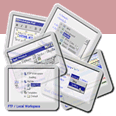Better way to display [error] messages
Application.MessageBox( 'File not found', 'Error', mb_OK ); |
Above method of displaying errors will make it harder to modify actual messages since they are distributed all over your application source code. It may be better to have a "centralized" function that can display error messages, or better yet, a centralized function that can display replaceable error messages. Consider the following example:
type
cnMessageIDs =
(
nMsgID_NoError,
nMsgID_FileNotFound,
nMsgID_OutOfMemory,
nMsgID_ExitProgram
// list your other error
// IDs here...
);
const
csMessages_ShortVersion
: array [ Low( cnMessageIDs )..
High( cnMessageIDs ) ]
of PChar =
(
'No error',
'File not found',
'Out of memory',
'Exit program?'
// other error messages...
);
csMessages_DetailedVersion
: array [ Low( cnMessageIDs )..
High( cnMessageIDs ) ]
of PChar =
(
'No error; please ignore!',
'File c:\config.sys not found.'+
'Contact your sys. admin.',
'Out of memory. You need '+
'at least 4M for this function',
'Exit program? '+
'Save your data first!'
// other error messages...
);
procedure MsgDisplay(
cnMessageID : cnMessageIDs );
begin
// set this to False to display
// short version of the messages
if( True )then
Application.MessageBox(
csMessages_DetailedVersion[
cnMessageID ],
'Error',
mb_OK )
else
Application.MessageBox(
csMessages_ShortVersion[
cnMessageID ],
'Error',
mb_OK );
end;
|
Now, whenever you want to display an error message, you can call the MsgDisplay() function with the message ID rather than typing the message itself:
MsgDisplay( nMsgID_FileNotFound ); |
MsgDisplay() function will not only let you keep all your error messages in one place -- inside one unit for example, but it will also let you keep different sets of error messages -- novice/expert, debug/release, and even different sets for different languages.
Random Tip : Quick way to print the directory listing
Next Tip : Calling CreateProcess() the easy way

